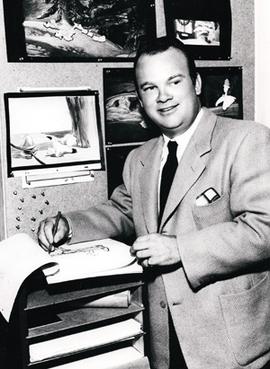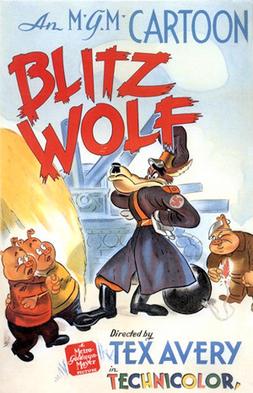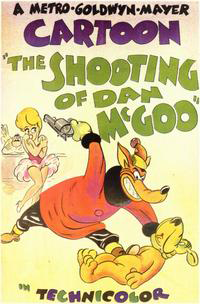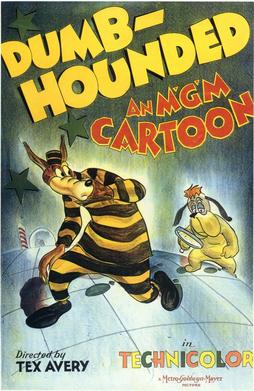
Frederick Bean "Tex" Avery was an American animator, cartoonist, director, and voice actor. He was known for directing and producing animated cartoons during the golden age of American animation. His most significant work was for the Warner Bros. and Metro-Goldwyn-Mayer studios, where he was crucial in the creation and evolution of famous animated characters such as Bugs Bunny, Daffy Duck, Porky Pig, Elmer Fudd, Droopy, Screwy Squirrel, The Wolf, Red Hot Riding Hood, and George and Junior.

The Big Bad Wolf is a fictional wolf appearing in several cautionary tales, including some of Grimms' Fairy Tales. Versions of this character have appeared in numerous works, and it has become a generic archetype of a menacing predatory antagonist.

Droopy is an animated character from the golden age of American animation. He is an anthropomorphic white Basset Hound with a droopy face; hence his name. He was created in 1943 by Tex Avery for theatrical cartoon shorts produced by the Metro-Goldwyn-Mayer cartoon studio. Essentially the polar opposite of Avery's other MGM character, the loud and wacky Screwy Squirrel, Droopy moves slowly and lethargically, speaks in a jowly monotone voice, and—though hardly an imposing character—is shrewd enough to outwit his enemies. When finally roused to anger, often by a bad guy laughing heartily at him, Droopy is capable of beating adversaries many times his size with a comical thrashing.

Red Hot Riding Hood, also known as Red and Miss Vavoom in the 1990s, is an American animated character, created by Tex Avery, who appears in several MGM short films and Tom and Jerry films. She is a fictional nightclub singer and dancer who is usually making all men in the room crazy, especially a Wolf character who—in vain—tries to seduce and chase her. Red debuted in MGM's Red Hot Riding Hood, a modern-day variant of the fairy tale "Little Red Riding Hood".
Screwy Squirrel is an animated cartoon character, an anthropomorphic squirrel created by Tex Avery for Metro-Goldwyn-Mayer.

Goldilocks and the Jivin' Bears is a 1944 Warner Bros. Merrie Melodies cartoon directed by Friz Freleng and produced by an uncredited Eddie Selzer. The short was released on September 2, 1944.

The Tex Avery Show is an American animated showcase series of Metro-Goldwyn-Mayer and Warner Bros. cartoon shorts prominently by animator Tex Avery. In between the shorts, Don Kennedy gives short facts about the cartoons. The showcase premiered on the Cartoon Network in 1996, and was taken off the air in 2002, while reruns continued to be shown on Cartoon Network until April 11, 2004. It was soon re-broadcast on Boomerang.

The Tom and Jerry Comedy Show is an American animated television series produced by Filmation for MGM Television featuring the popular cartoon duo Tom and Jerry. The show first aired on September 6, 1980 on CBS and continued until December 13 the same year. Its episodes were eventually added to syndicated Tom and Jerry packages in 1983. Episodes of the show also occasionally appeared on Cartoon Network and Boomerang.

Little Red Riding Rabbit is a 1944 Warner Bros. Merrie Melodies cartoon, directed by Friz Freleng, and starring Bugs Bunny. It is a sendup of the "Little Red Riding Hood" story, and is the first time in which Mel Blanc receives a voice credit.

Swing Shift Cinderella is a 1945 MGM animated cartoon short subject directed by Tex Avery. The plot involves the Big Bad Wolf and Cinderella. Frank Graham voiced the wolf, and Sara Berner voiced both Cinderella and The Fairy Grandmother, with Imogene Lynn providing the former's singing voice.
Preston Erwin Blair was an American character animator, best remembered for his work at Walt Disney Productions and the Metro-Goldwyn-Mayer cartoon studio.

Little Red Walking Hood is a 1937 Merrie Melodies cartoon supervised by Fred Avery. The short was released on November 6, 1937, and features the first appearance of an early character who later became Elmer Fudd.

The Metro-Goldwyn-Mayer cartoon studio was an American animation studio operated by Metro-Goldwyn-Mayer (MGM) during the Golden Age of American animation. Active from 1937 until 1957, the studio was responsible for producing animated shorts to accompany MGM feature films in Loew's Theaters, which included popular cartoon characters Tom, Jerry, Droopy, Butch, Spike, Tyke, and Barney Bear.

Blitz Wolf is a 1942 American animated propaganda short film produced and distributed by Metro-Goldwyn-Mayer. A parody of the Three Little Pigs told via a World War II perspective, the short was directed by Tex Avery and produced by Fred Quimby. It was nominated for the Academy Award for Best Short Subject: Cartoons but lost to Der Fuehrer's Face, another anti-Nazi World War II parody featuring Donald Duck.

The Shooting of Dan McGoo is a cartoon directed by Tex Avery and starring Frank Graham as the Wolf. Both Bill Thompson and Avery himself voiced the lead character Droopy. Sara Berner did the speaking voice of Lou, while her singing was provided by Imogene Lynn. The cartoon was edited for a 1951 re-release. It is a loose remake of Avery's 1939 cartoon for Warner Bros., Dangerous Dan McFoo.

Wild and Woolfy is a 1945 animated cartoon short, one of six cartoons in which Droopy was paired with a wolf as his acting partner. It is one of a very few cartoons in the series where Bill Thompson did not voice Droopy, instead Tex Avery himself provided the voice.

Northwest Hounded Police is a 1946 American animated short film directed by Tex Avery, produced by Fred Quimby, and featuring Droopy and Avery's wolf character. A remake of Droopy's first cartoon Dumb-Hounded, the short revolves around the wolf on the run from Droopy, who is trailing the wolf in order to capture him. The title is a play on words on the film North West Mounted Police (1940).

Little Rural Riding Hood is a 1949 MGM animated cartoon short subject directed by Tex Avery, conceived as a follow-up to his 1943 cartoon Red Hot Riding Hood.

Dumb-Hounded is a 1943 American animated short film directed by Tex Avery and written by Rich Hogan. It was the first cartoon to feature Droopy. The film was released on March 20, 1943 by Metro-Goldwyn-Mayer.
Tex Avery Screwball Classics is a series of single-disc Blu-ray and DVD sets by Warner Bros. Home Entertainment's Warner Archive unit collecting various theatrical cartoons from animation director Tex Avery during his tenure at the Metro-Goldwyn-Mayer studio's cartoon division between the years of 1942 and 1955. It is the first comprehensive collection of Avery's MGM shorts to be released on home media in North America since The Compleat Tex Avery series of laserdiscs in the 1990s, with many of the shorts having been previously unreleased on DVD or Blu-ray.
















